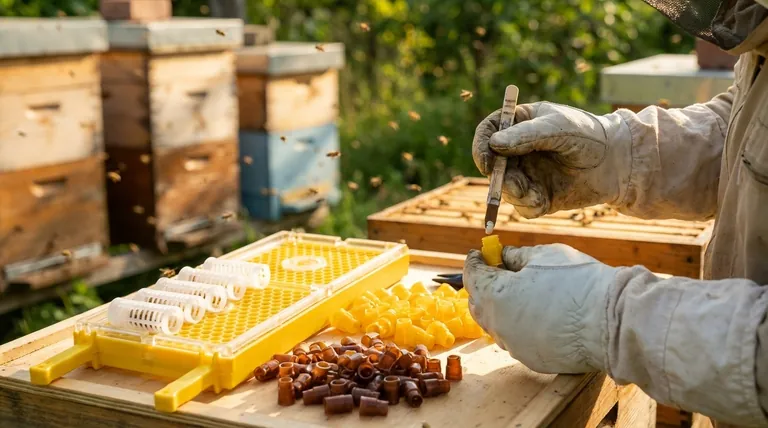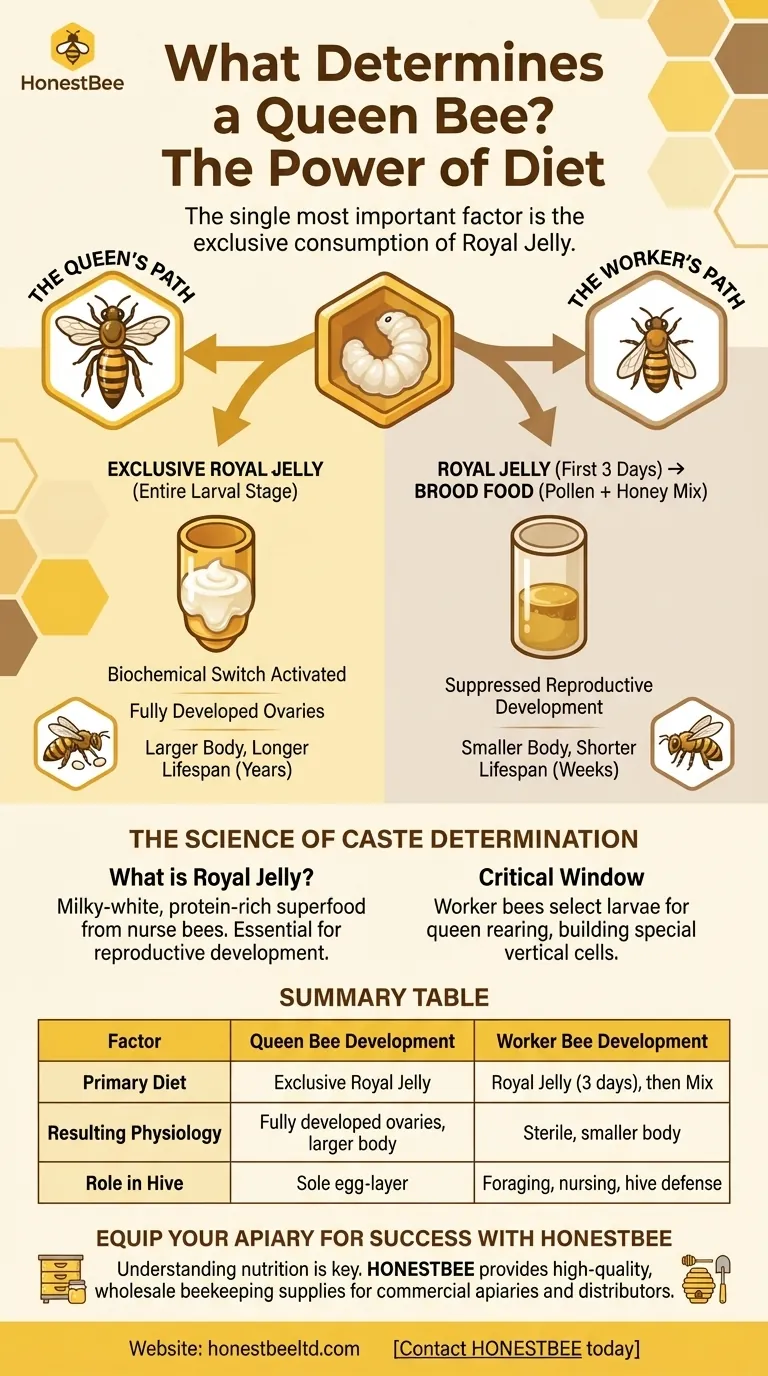The single most important factor that determines whether a honey bee larva develops into a queen is its diet. Specifically, future queens are fed an exclusive, protein-rich diet of a substance called royal jelly for their entire larval stage. In contrast, larvae destined to become worker bees are only fed royal jelly for the first few days before being switched to a less nutritious diet.
The destiny of a honey bee is not predetermined by genetics alone; it is dictated by nutrition. An exclusive diet of royal jelly is the biochemical switch that activates the developmental pathway to royalty, turning a generic female larva into a queen.

The Science of Caste Determination
The development of a bee into either a queen or a sterile worker is one of the most fascinating examples of developmental plasticity in nature. It highlights how environment and nutrition can dramatically alter an organism's future.
What is Royal Jelly?
Royal jelly is a milky-white, protein-rich secretion produced by the hypopharyngeal and mandibular glands of young nurse bees. It is a complex mixture of water, proteins, sugars, lipids, vitamins, and minerals.
Think of it as a biological superfood, specifically formulated to trigger the full reproductive development of a female bee.
The Critical Developmental Window
For a larva to become a queen, this special diet is not optional—it's essential. Worker bees actively decide which larvae will be groomed for queenship.
They construct special, vertically oriented "queen cells" around chosen larvae and continuously provision them with vast quantities of royal jelly.
The "Worker" Diet: A Path of Limitation
Larvae destined to become worker bees receive a different treatment. They are fed royal jelly for only the first three days.
After this initial period, their diet is changed to "worker jelly" or "brood food," a mixture of royal jelly, honey, and pollen. This less-rich diet suppresses the development of their reproductive organs, ensuring they become sterile female workers.
The Implications of a Royal Diet
The dietary difference has profound and lifelong consequences for the bee, creating two distinct castes from genetically similar individuals.
Physiological Transformation
An exclusive diet of royal jelly activates specific genes and hormonal pathways. This leads to the full development of the queen's ovaries, which are necessary for her role as the colony's sole egg-layer.
It also results in a larger body size, a longer abdomen, and a different internal anatomy compared to a worker bee.
Lifespan and Role
The impact extends far beyond reproduction. A queen bee can live for several years, laying thousands of eggs per day at her peak.
A worker bee, by contrast, lives for only a few weeks in the busy season. Her suppressed reproductive system allows her to focus entirely on tasks like foraging, nursing, and defending the hive.
How to Apply This Knowledge
Understanding this mechanism is fundamental to beekeeping and hive management.
- If your primary focus is queen rearing: You can mimic the natural process by grafting young larvae into artificial queen cups and ensuring they are placed in a strong "cell builder" colony with an abundance of nurse bees ready to produce royal jelly.
- If your primary focus is preventing swarms: You can manage the hive to reduce the triggers for queen cell creation, such as overcrowding, which signals to the workers that it's time to raise a new queen.
- If your primary focus is identifying hive health: The presence of queen cells (and the royal jelly within them) is a clear indicator of the colony's intention to replace their queen, either through emergency, supersedure, or swarming.
Ultimately, the power to create a queen lies not in a special egg, but in the collective decision of the worker bees to provide a specific, powerful diet.
Summary Table:
| Factor | Queen Bee Development | Worker Bee Development |
|---|---|---|
| Primary Diet | Exclusive Royal Jelly (entire larval stage) | Royal Jelly (first 3 days), then Honey/Pollen Mix |
| Resulting Physiology | Fully developed ovaries, larger body, longer lifespan | Sterile, smaller body, shorter lifespan |
| Role in Hive | Sole egg-layer, colony reproduction | Foraging, nursing, hive defense |
| Key Takeaway | Diet, not genetics, is the primary determinant of caste. |
Equip Your Apiary for Success with HONESTBEE
Understanding the critical role of nutrition is just the first step. Successfully managing queen rearing, swarm prevention, and overall hive health requires the right tools and equipment.
HONESTBEE supplies commercial apiaries and beekeeping equipment distributors with the high-quality, wholesale supplies needed to support strong, productive colonies. From grafting tools for precise queen rearing to essential hive components that prevent overcrowding, our products are designed for beekeepers who understand the science behind the swarm.
Let us help you build a stronger operation.
Contact HONESTBEE today to discuss your wholesale needs and discover how our beekeeping supplies can contribute to your success.
Visual Guide

Related Products
- Jenter Queen Rearing Kit Complete Set for Bee Breeding
- No Grafting Queen Rearing Kit: System for Royal Jelly Production and Queen Rearing
- Nicot Queen Rearing Kit for Beekeeping and Grafting in Nicot System
- Brown Nicot Queen Cell Cups for Breeding Queen Bees Beekeeping
- Wooden Queen Bee Excluder for Beekeeping
People Also Ask
- What are the stages involved in queen raising? A Guide to Controlled, High-Quality Queen Production
- Why is raising queens beneficial for beekeepers? Gain Control Over Genetics and Costs
- What genetic pathways differ in QE-queens? Unlocking the Master Controls of Queen Bee Biology
- How can beekeepers start a honey bee breeding program? Build a Superior, Resilient Apiary
- What is queen rearing in beekeeping? Take Control of Your Apiary's Genetics



















